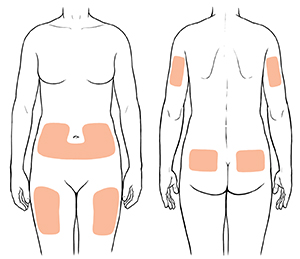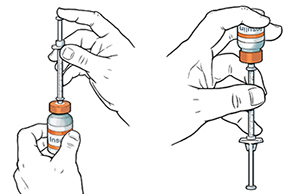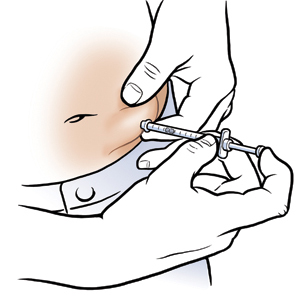Insulin: How to Use and Where to Inject
Insulin: How to Use and Where to Inject

Where to inject your insulin
Injecting insulin in the same area (like your belly) means that insulin is absorbed the same way.
Insulin is most often injected in the abdominal fat. That is where it is absorbed most quickly.
Change the injection site each time you give yourself insulin. This helps prevent problems.
Have an organized way of moving from site to site.
Leave at least 2 inches around your belly button (navel).
When to inject your insulin
Make sure you follow your healthcare provider's instructions about when you should give yourself insulin.
The timing of insulin injections with meals or snacks is very important.
Getting ready to inject insulin from a bottle
Wash your hands. Use soap and warm water.
Wipe the top of the insulin bottle (vial) with alcohol.
Preparing the insulin
Pull back the plunger until the end of the plunger is even with the number of units of insulin you take. Always read the numbers of units of insulin at your eye level.
Insert the needle into the top of the bottle. Hold the needle and bottle straight up and down. Make sure the needle is in the insulin. Then push the plunger in all the way, pushing air into the insulin.
Turn the bottle and syringe upside down so that the bottle is on top.
Pull back on the plunger until the end of the plunger is even with the number of units of insulin you take.
Remove the needle. Then tap the syringe with a fingertip to remove any air bubbles.
Injecting the insulin
Gently pinch up about 1 inch of skin. Do not squeeze the skin.
Insert the needle.
Push in the plunger. Press until the syringe is empty. Let go of the skin. Then remove the needle. Don’t rub the site after you remove the needle.
Disposing of the syringe
Put the needle and syringe in a sharps container. And don’t recap the needle.
You can buy a sharps container at a pharmacy or medical supply store. Or, you can also use an empty laundry detergent bottle, or any other puncture-proof container and lid.
When the sharps container is full, put it into a garbage bag and secure the top. Label the bag “needles” or “sharps.”
Call your local waste company to ask about removing the sharps container. You can also check with the Coalition for Safe Community Needle Disposal at 800-643-1643, www.safeneedledisposal.org.
Storing your insulin
Keep unopened insulin bottles in the refrigerator. An open bottle can be stored at room temperature (such as on the kitchen counter). But don’t let the insulin get too hot. Always keep it below 86°F (30°C). And never let it freeze!
Always use insulin before the expiration date on the bottle. Throw expired bottles away.
Use insulin within 28 days of opening the bottle. After 28 days, throw it away. To remember, write the date you opened it on the bottle.
When you travel, be sure to take all of your diabetes supplies. Put them in a bag made to protect insulin from heat and cold. Always keep them with you. If there is a delay or your suitcase is lost, you will have what you need.
Never leave insulin in the car. It can get too hot or too cold.
Updated:
November 18, 2017
Sources:
General Principles of Insulin Therapy in Diabetes Mellitus. UpToDate
Reviewed By:
Brown, Kim, APRN,Hurd, Robert, MD,Image reviewed by StayWell medical illustration team.,Turley, Raymond Kent, BSN, MSN, RN

